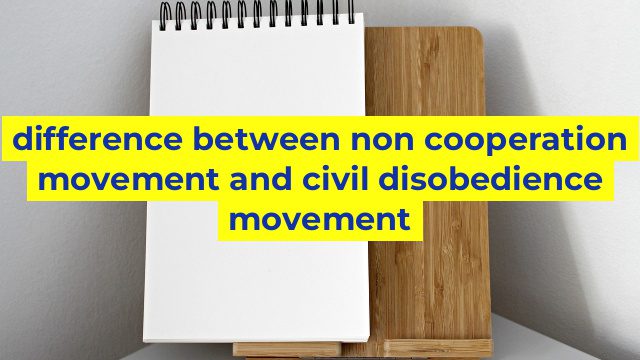Difference between Non-Cooperation Movement and Civil Disobedience Movement
Introduction
Mahatma Gandhi is known for leading several freedom movements throughout India’s struggle for independence. The two most significant ones are the Non-Cooperation Movement and the Civil Disobedience Movement. Though the aim of both the movements was the same, there are several differences between them.
Meaning of Non-Cooperation Movement
The Non-Cooperation Movement was initiated in 1920 by Mahatma Gandhi against the British Raj. The primary aim of the movement was to compel the British government to provide more rights to the Indian people. In this movement, the Indian people were asked to boycott British goods, schools, colleges, courts, and government services. The movement used non-violent protests as its primary method of bringing the British government to its knees.
Meaning of Civil Disobedience Movement
The Civil Disobedience Movement was initiated in 1930 by Mahatma Gandhi as a part of India’s struggle for independence. The primary aim of this movement was to protest against the salt tax imposed by the British government in India. The movement involved breaking the law in a peaceful manner as a sign of protest. The participants of the movement demonstrate their disobedience by not paying the salt tax and making salt from seawater. Civil disobedience was used at this movement as the primary form of protest against the British Raj.
The difference between Non-Cooperation Movement and Civil Disobedience Movement
Though the Non-Cooperation Movement and Civil Disobedience Movement share a common aim, they are different in their methods.
The Non-Cooperation Movement was primarily a boycott campaign that aimed to isolate the British Raj economically and politically. The Civil Disobedience Movement, on the other hand, was more of a direct protest movement where Indians openly broke the law to bring the British Raj to its knees.
The Non-Cooperation Movement was characterized by hartals, boycotts of foreign goods, and avoidance of British institutions. In contrast, the Civil Disobedience Movement involved direct action such as the Salt Satyagraha, the Quit India Movement, and the Bardoli Satyagraha.
Another significant difference is the period in which the movements took place. The Non-Cooperation Movement occurred in the 1920s, while the Civil Disobedience Movement occurred in the 1930s.
Conclusion
In conclusion, both the Non-Cooperation Movement and the Civil Disobedience Movement played a significant role in India’s fight for independence. Though the methods used in both movements were different, their aim was the same – to compel the British Raj to provide more rights to the Indian people. These movements were instrumental in shaping the Indian independence movement and paving the way for India’s freedom from British rule.
Table difference between non cooperation movement and civil disobedience movement
| Non-Cooperation Movement | Civil Disobedience Movement |
|---|---|
| The Non-Cooperation Movement was launched in 1920. | The Civil Disobedience Movement was launched in 1930. |
| The Non-Cooperation Movement was led by Mahatma Gandhi. | The Civil Disobedience Movement was also led by Mahatma Gandhi. |
| The goal of the Non-Cooperation Movement was to gain independence from British colonial rule. | The goal of the Civil Disobedience Movement was also to gain independence from British colonial rule. |
| The Non-Cooperation Movement aimed at reducing British economic and administrative power in India. | The Civil Disobedience Movement aimed at breaking British law and undermining the British government in India. |
| The Non-Cooperation Movement encouraged Indians to boycott British goods, schools, and government institutions. | The Civil Disobedience Movement involved nonviolent non-cooperation with British authorities, including nonpayment of taxes and refusal to follow British laws. |
| The Non-Cooperation Movement was called off by Mahatma Gandhi after the Chauri Chaura incident in which police were killed by protesters. | The Civil Disobedience Movement was called off by Mahatma Gandhi after the signing of the Gandhi-Irwin Pact in 1931. |

